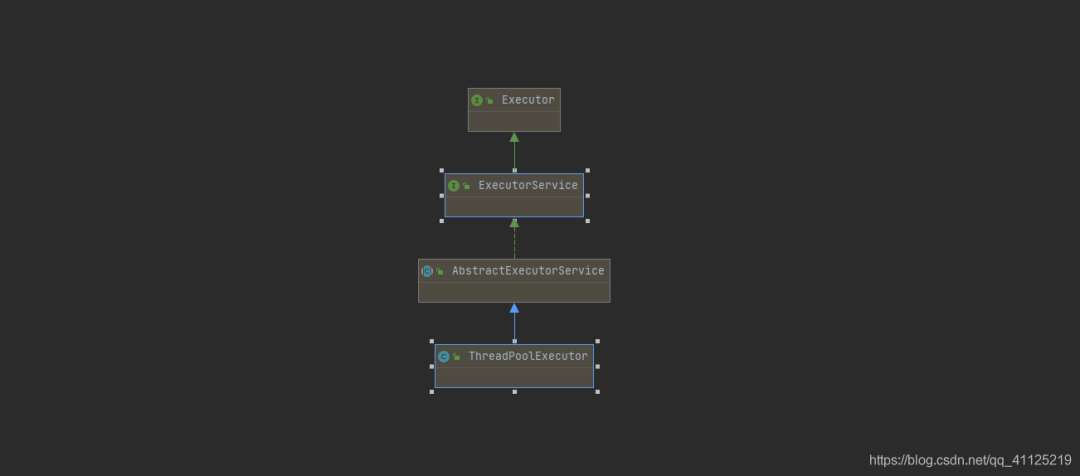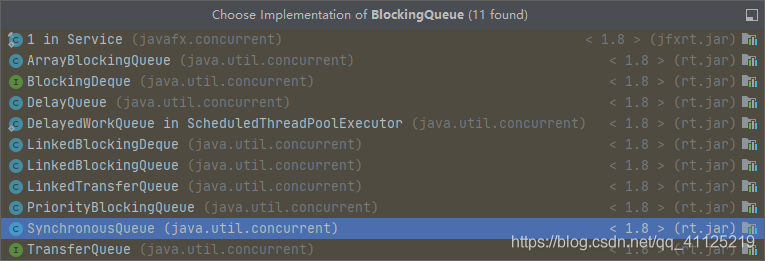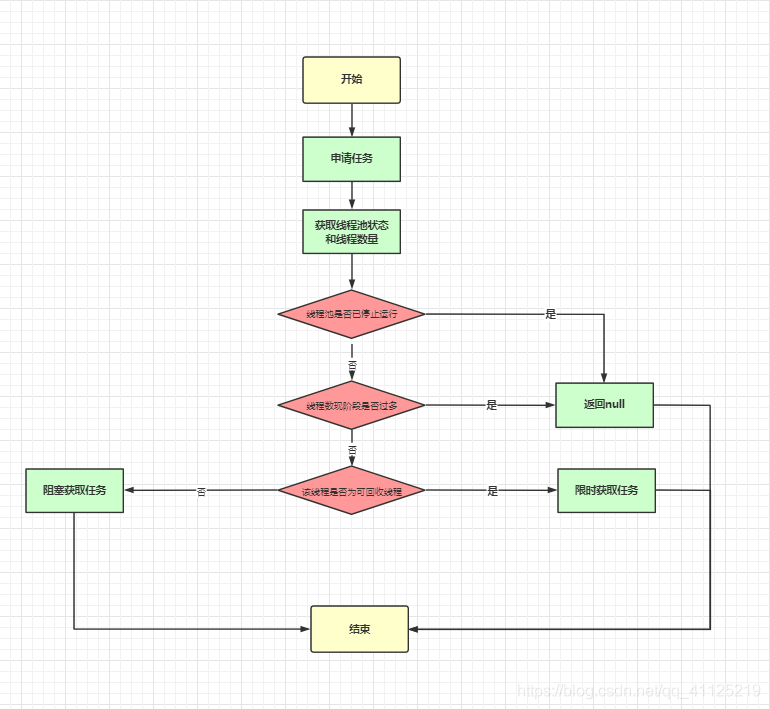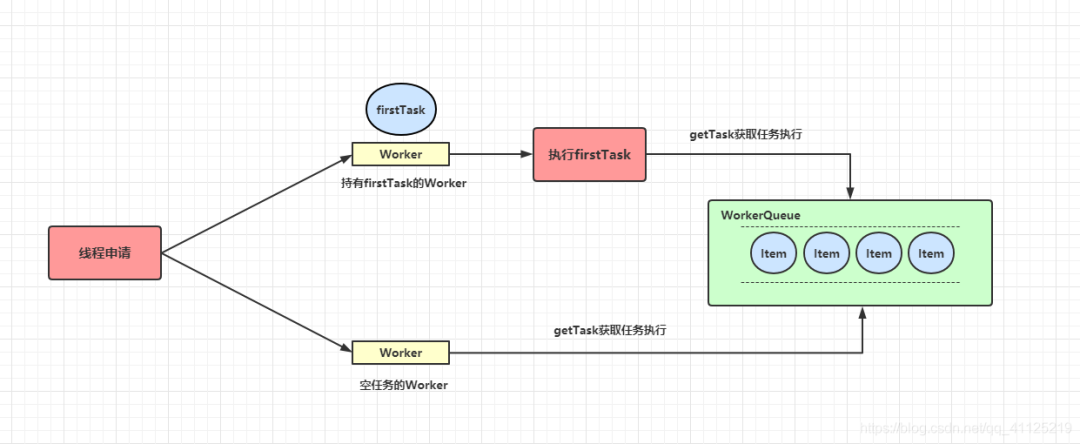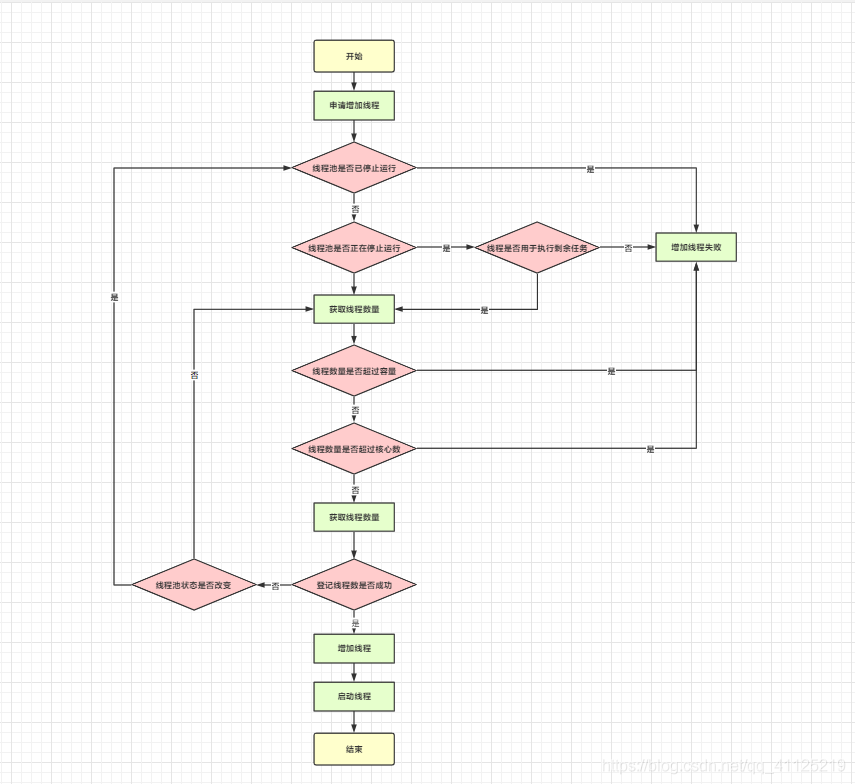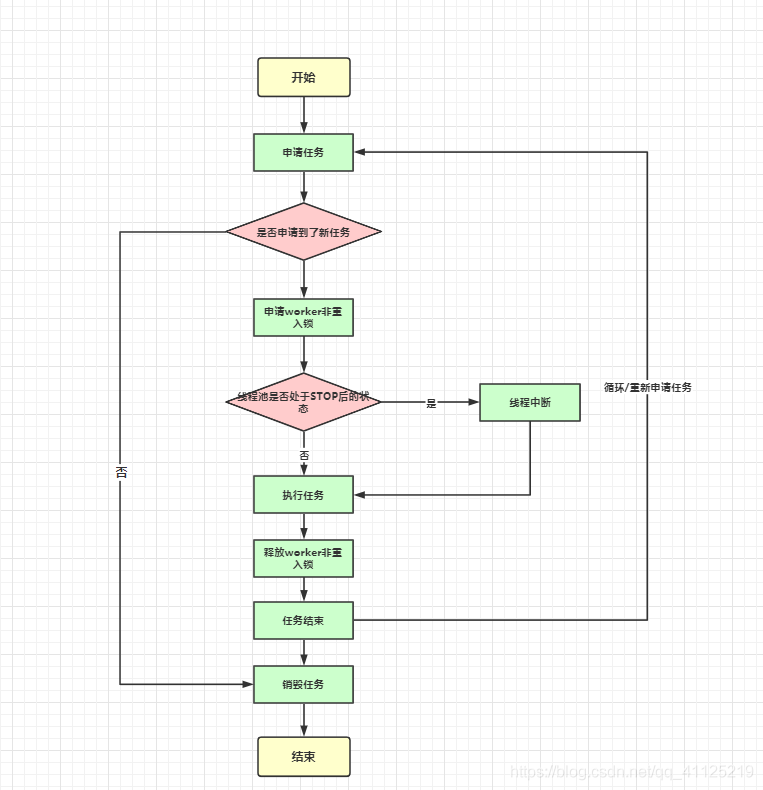详述Java线程池实现原理
点击上方蓝色字体,选择“标星公众号”
优质文章,第一时间送达
一、写在前面
1.1 线程池是什么
线程池(Thread Pool) 是一种池化思想管理线程的工具,经常出现在多线程服务器中,如MySQL。
线程过多会带来额外的开销,其中包括创建销毁线程的开销,操作系统调度线程的开销等等,同时也降低了计算机的整体性能。线程池维护多个线程,等待监督管理者分配可并发执行的任务。这种做法,一方面避免了处理任务是创建销毁线程开销代价,另一方面避免了线程数量膨胀导致的过分调度问题,保证了对操作系统内核的充分利用。
本文描述的线程池是JDK提供的ThreadPoolExecutor类
1.2 线程池解决的问题是什么
线程池解决的问题就是资源管理的问题。在并发环境下,系统不能够确定在任意时刻有多少任务需要执行,有多少资源需要投入。
二、线程池和核心设计与实现
2.1 总体设计
2.2 生命周期管理
private final AtomicInteger ctl = new AtomicInteger(ctlOf(RUNNING, 0));
// Packing and unpacking ctl
// 计算当前运行状态
private static int runStateOf(int c) { return c & ~CAPACITY; }
// 计算当前线程数据
private static int workerCountOf(int c) { return c & CAPACITY; }
// 通过状态和线程数生成ctl
private static int ctlOf(int rs, int wc) { return rs | wc; }
// runState is stored in the high-order bits
private static final int RUNNING = -1 << COUNT_BITS;
private static final int SHUTDOWN = 0 << COUNT_BITS;
private static final int STOP = 1 << COUNT_BITS;
private static final int TIDYING = 2 << COUNT_BITS;
private static final int TERMINATED = 3 << COUNT_BITS;
| 运行状态 | 状态描述 |
|---|---|
| RUNNING | 能接受新提交的任务,并且也能处理阻塞队列中的任务 |
| SHUTDOWN | 状态关闭,不在接受新提交的任务,但是能继续处理阻塞队列已保存的让任务 |
| STOP | 不接受新任务,也不处理队列中的任务,会中断正在处理任务的线程 |
| TIDYING | 所有让任务都已终止,workerCount(有效处理让任务线程)状态为0 |
| TERMINATED | 在terminated()方法执行结束后进入该状态 |
2.3 任务调度机制
2.3.1 任务调度
2.3.2 任务缓冲
| 名称 | 描述 |
|---|---|
| ArrayBlockingQueue | 一个用数组实现的有界阻塞队列,此队列按照先进先出(FIFO)的原则对元素进行排序。支持公平锁和非公平锁 |
| LinkedBlockingDeque | 一个由链表结构组成的有界队列,此队列按照先进先出(FIFO)的原则对元素进行排序。此队列的默认长度为Integer.MAX_VALUE,所以默认创建此队列有容量危险 |
| PriorityBlockingQueue | 一个支持线程优先级排序的无界队列,默认自然进行排序,也可以自定义实现compareTo()方法指定排序故障,不能保证同优先级元素的顺序。 |
| DelayQueue | 一个实现PriorityBlockingQueue实现延迟获取的无界队列,在创建元素时,可以指定多久才能从队列中获取当前元素。只有延迟期满后才能从队列中获取元素。 |
| SynchronousQueue | 一个不存储元素的阻塞队列,每个put操作必须等待take操作,否则不能添加元素。支持公平锁和非公平锁。SynchronousQueue的一个使用场景是在线程池里。Executors.newCachedThreadPool()就使用了SynchronousQueue,这个线程池根据需要(新任务来)创建新的线程,如果有空闲的线程就使用空闲线程,线程空闲60秒会被回收。 return new ThreadPoolExecutor( 0, Integer.MAX_VALUE, 60L, TimeUnit.SECONDS, new SynchronousQueue()); |
| LinkedTransferQueue | 一个由链表结构组成的无界阻塞队列,相当于其他队列,LinkedTransferQueue多了transfer和tryTransfer方法 |
| LinkedBlockingQueue | 一个由链表结构组成的双向阻塞队列,队列的头部和尾部都可以插入和删除元素,多线程并发时,可以将锁的竞争最多降到一半 |
2.3.3 任务申请
private Runnable getTask() {
boolean timedOut = false; // Did the last poll() time out?
for (;;) {
int c = ctl.get();
int rs = runStateOf(c);
// Check if queue empty only if necessary.
// 判断线程池是否已停止运行
if (rs >= SHUTDOWN && (rs >= STOP || workQueue.isEmpty())) {
decrementWorkerCount();
return null;
}
int wc = workerCountOf(c);
// Are workers subject to culling?
boolean timed = allowCoreThreadTimeOut || wc > corePoolSize;
// 判断线程现阶段是否够多
if ((wc > maximumPoolSize || (timed && timedOut))
&& (wc > 1 || workQueue.isEmpty())) {
if (compareAndDecrementWorkerCount(c))
return null;
continue;
}
// 限时任务获取和阻塞获取
try {
Runnable r = timed ?
workQueue.poll(keepAliveTime, TimeUnit.NANOSECONDS) :
workQueue.take();
if (r != null)
return r;
timedOut = true;
} catch (InterruptedException retry) {
timedOut = false;
}
}
}
2.3.4 任务拒绝
public interface RejectedExecutionHandler {
/**
* Method that may be invoked by a {@link ThreadPoolExecutor} when
* {@link ThreadPoolExecutor#execute execute} cannot accept a
* task. This may occur when no more threads or queue slots are
* available because their bounds would be exceeded, or upon
* shutdown of the Executor.
*
* <p>In the absence of other alternatives, the method may throw
* an unchecked {@link RejectedExecutionException}, which will be
* propagated to the caller of {@code execute}.
*
* @param r the runnable task requested to be executed
* @param executor the executor attempting to execute this task
* @throws RejectedExecutionException if there is no remedy
*/
void rejectedExecution(Runnable r, ThreadPoolExecutor executor);
}
| 名称 | 描述 |
|---|---|
| ThreadPoolExecutor.AbortPolicy | 丢弃任务并抛出RejectedExecutionException异常。这是线程池默认的拒绝策略,在任务不能在提交的时候,抛出异常,及时反馈程序运行状态。如果是比较关键的业务,推荐使用该策略,这样子在系统不能承载更大并发的时候,能过及时的通过异常发现。 |
| ThreadPoolExecutor.DiscardPolicy | 丢弃任务,但是不抛出异常。使用该策略,可能会使我们无法发现系统的异常状态。建议一些无关紧要的业务采用此策略。 |
| ThreadPoolExecutor.DiscardOldestPolicy | 丢弃队列最前面的任务,然后重新提交比拒接的任务。是否要采用此种策略,需要根据实际业务是否允许丢弃老任务来认真衡量 |
| ThreadPoolExecutor.CallerRunsPolicy | 由调用线程(提交任务的线程)来处理任务。这种情况是需要让所有的任务都执行完毕,那么就适合大量计算的任务类型去执行,多线程仅仅是增加大吞吐量的手段,最终必须要让每个任务都执行 |
/**
* A handler for rejected tasks that runs the rejected task
* directly in the calling thread of the {@code execute} method,
* unless the executor has been shut down, in which case the task
* is discarded.
*/
public static class CallerRunsPolicy implements RejectedExecutionHandler {
/**
* Creates a {@code CallerRunsPolicy}.
*/
public CallerRunsPolicy() { }
/**
* Executes task r in the caller's thread, unless the executor
* has been shut down, in which case the task is discarded.
*
* @param r the runnable task requested to be executed
* @param e the executor attempting to execute this task
*/
public void rejectedExecution(Runnable r, ThreadPoolExecutor e) {
if (!e.isShutdown()) {
r.run();
}
}
}
/**
* A handler for rejected tasks that throws a
* {@code RejectedExecutionException}.
*/
public static class AbortPolicy implements RejectedExecutionHandler {
/**
* Creates an {@code AbortPolicy}.
*/
public AbortPolicy() { }
/**
* Always throws RejectedExecutionException.
*
* @param r the runnable task requested to be executed
* @param e the executor attempting to execute this task
* @throws RejectedExecutionException always
*/
public void rejectedExecution(Runnable r, ThreadPoolExecutor e) {
throw new RejectedExecutionException("Task " + r.toString() +
" rejected from " +
e.toString());
}
}
/**
* A handler for rejected tasks that silently discards the
* rejected task.
*/
public static class DiscardPolicy implements RejectedExecutionHandler {
/**
* Creates a {@code DiscardPolicy}.
*/
public DiscardPolicy() { }
/**
* Does nothing, which has the effect of discarding task r.
*
* @param r the runnable task requested to be executed
* @param e the executor attempting to execute this task
*/
public void rejectedExecution(Runnable r, ThreadPoolExecutor e) {
}
}
/**
* A handler for rejected tasks that discards the oldest unhandled
* request and then retries {@code execute}, unless the executor
* is shut down, in which case the task is discarded.
*/
public static class DiscardOldestPolicy implements RejectedExecutionHandler {
/**
* Creates a {@code DiscardOldestPolicy} for the given executor.
*/
public DiscardOldestPolicy() { }
/**
* Obtains and ignores the next task that the executor
* would otherwise execute, if one is immediately available,
* and then retries execution of task r, unless the executor
* is shut down, in which case task r is instead discarded.
*
* @param r the runnable task requested to be executed
* @param e the executor attempting to execute this task
*/
public void rejectedExecution(Runnable r, ThreadPoolExecutor e) {
if (!e.isShutdown()) {
e.getQueue().poll();
e.execute(r);
}
}
}
2.4 Worker线程管理
2.4.1 Worker线程
private final class Worker
extends AbstractQueuedSynchronizer
implements Runnable
{
/** Thread this worker is running in. Null if factory fails. */
// worker持有的线程
final Thread thread;
/** Initial task to run. Possibly null. */
// 初始化的任务,可以为null
Runnable firstTask;
...
}
/**
* The queue used for holding tasks and handing off to worker
* threads. We do not require that workQueue.poll() returning
* null necessarily means that workQueue.isEmpty(), so rely
* solely on isEmpty to see if the queue is empty (which we must
* do for example when deciding whether to transition from
* SHUTDOWN to TIDYING). This accommodates special-purpose
* queues such as DelayQueues for which poll() is allowed to
* return null even if it may later return non-null when delays
* expire.
*/
# workerQueue 源码定义
private final BlockingQueue<Runnable> workQueue;
/**
* Set containing all worker threads in pool. Accessed only when
* holding mainLock.
*/
private final HashSet<Worker> workers = new HashSet<Worker>();
private final class Worker
extends AbstractQueuedSynchronizer
implements Runnable
public void shutdown() {
final ReentrantLock mainLock = this.mainLock;
mainLock.lock();
try {
checkShutdownAccess();
advanceRunState(SHUTDOWN);
// 执行interruptIdleWorkers方法
interruptIdleWorkers();
onShutdown(); // hook for ScheduledThreadPoolExecutor
} finally {
mainLock.unlock();
}
tryTerminate();
}
final void tryTerminate() {
for (;;) {
int c = ctl.get();
if (isRunning(c) ||
runStateAtLeast(c, TIDYING) ||
(runStateOf(c) == SHUTDOWN && ! workQueue.isEmpty()))
return;
if (workerCountOf(c) != 0) { // Eligible to terminate
// 执行interruptIdleWorkers
interruptIdleWorkers(ONLY_ONE);
return;
}
final ReentrantLock mainLock = this.mainLock;
mainLock.lock();
try {
if (ctl.compareAndSet(c, ctlOf(TIDYING, 0))) {
try {
terminated();
} finally {
ctl.set(ctlOf(TERMINATED, 0));
termination.signalAll();
}
return;
}
} finally {
mainLock.unlock();
}
// else retry on failed CAS
}
}
private void interruptIdleWorkers(boolean onlyOne) {
final ReentrantLock mainLock = this.mainLock;
mainLock.lock();
try {
for (Worker w : workers) {
Thread t = w.thread;
if (!t.isInterrupted() && w.tryLock()) {
try {
t.interrupt();
} catch (SecurityException ignore) {
} finally {
w.unlock();
}
}
if (onlyOne)
break;
}
} finally {
mainLock.unlock();
}
}
2.4.2 worker线程增加
private boolean addWorker(Runnable firstTask, boolean core) {
retry:
for (;;) {
int c = ctl.get();
int rs = runStateOf(c);
// 判断线程是否已经停止
// 判断线程是否正在停止 如果是则判断线程是否用于执行剩余任务firstTask
// workQueue是否为空
if (rs >= SHUTDOWN &&
! (rs == SHUTDOWN &&
firstTask == null &&
! workQueue.isEmpty()))
return false;
for (;;) {
// 获取线程数量
int wc = workerCountOf(c);
// 判断线程是否超过容量
// 判断线程是否超过对应核心数 上面讲了core 传true/false区别
if (wc >= CAPACITY ||
wc >= (core ? corePoolSize : maximumPoolSize))
return false;
if (compareAndIncrementWorkerCount(c))
break retry;
c = ctl.get(); // Re-read ctl
if (runStateOf(c) != rs)
continue retry;
// else CAS failed due to workerCount change; retry inner loop
}
}
// 尝试登记线程
boolean workerStarted = false;
boolean workerAdded = false;
Worker w = null;
try {
w = new Worker(firstTask);
final Thread t = w.thread;
if (t != null) {
// 加锁
final ReentrantLock mainLock = this.mainLock;
mainLock.lock();
try {
// Recheck while holding lock.
// Back out on ThreadFactory failure or if
// shut down before lock acquired.
int rs = runStateOf(ctl.get());
// 判断线程池状态是否改变
if (rs < SHUTDOWN ||
(rs == SHUTDOWN && firstTask == null)) {
if (t.isAlive()) // precheck that t is startable
throw new IllegalThreadStateException();
// 增加线程
workers.add(w);
int s = workers.size();
if (s > largestPoolSize)
largestPoolSize = s;
workerAdded = true;
}
} finally {
// 释放锁
mainLock.unlock();
}
// 增加成功启动线程
if (workerAdded) {
t.start();
workerStarted = true;
}
}
} finally {
if (! workerStarted)
addWorkerFailed(w);
}
return workerStarted;
}
2.4.3 worker线程回收
final void runWorker(Worker w) {
Thread wt = Thread.currentThread();
Runnable task = w.firstTask;
w.firstTask = null;
w.unlock(); // allow interrupts
boolean completedAbruptly = true;
try {
while (task != null || (task = getTask()) != null) {
// 执行任务
} finally {
// 获取不到任务,主动回收自己
processWorkerExit(w, completedAbruptly);
}
}
private void processWorkerExit(Worker w, boolean completedAbruptly) {
if (completedAbruptly) // If abrupt, then workerCount wasn't adjusted
decrementWorkerCount();
final ReentrantLock mainLock = this.mainLock;
mainLock.lock();
try {
completedTaskCount += w.completedTasks;
// 回收
workers.remove(w);
} finally {
mainLock.unlock();
}
...
}
2.4.4 worker线程执行任务
2.4.5 worker如何保证核心线程不被回收
public void execute(Runnable command) {
// 提交任务为null 抛出异常
if (command == null)
throw new NullPointerException();
// 获取线程池状态\线程池线程数据
int c = ctl.get();
// 小于核心线程数 addWorker()
if (workerCountOf(c) < corePoolSize) {
if (addWorker(command, true))
return;
c = ctl.get();
}
// 大于核心线程数,当前线程池是运行状态,向阻塞队列中添加任务
if (isRunning(c) && workQueue.offer(command)) {
int recheck = ctl.get();
if (! isRunning(recheck) && remove(command))
reject(command);
else if (workerCountOf(recheck) == 0)
addWorker(null, false);
}
// 队列添加失败 拒绝策略处理
else if (!addWorker(command, false))
reject(command);
}
private boolean addWorker(Runnable firstTask, boolean core) {
retry:
// 死循环
for (;;) {
int c = ctl.get();
int rs = runStateOf(c);
// 如果当前线程状态是SHUTDOWN STOP TIDYING TERMINATED 并且SHUTDOWN状态时任务队列为空 返回false
// Check if queue empty only if necessary.
if (rs >= SHUTDOWN &&
! (rs == SHUTDOWN &&
firstTask == null &&
! workQueue.isEmpty()))
return false;
// 死循环
for (;;) {
int wc = workerCountOf(c);
// core参数 true corePoolSize核心线程数 false maximumPoolSize最大线程数
// CAPACITY integer最大值 (1 << COUNT_BITS) - 1;
if (wc >= CAPACITY ||
wc >= (core ? corePoolSize : maximumPoolSize))
return false;
// 如果增加任务成功,退出该循环执行下面代码,否则继续
if (compareAndIncrementWorkerCount(c))
break retry;
c = ctl.get(); // Re-read ctl
if (runStateOf(c) != rs)
continue retry;
// else CAS failed due to workerCount change; retry inner loop
}
}
boolean workerStarted = false;
boolean workerAdded = false;
Worker w = null;
try {
// 重点代码 后续分析
w = new Worker(firstTask);
final Thread t = w.thread;
if (t != null) {
// 内置锁 加锁
final ReentrantLock mainLock = this.mainLock;
mainLock.lock();
try {
// Recheck while holding lock.
// Back out on ThreadFactory failure or if
// shut down before lock acquired.
int rs = runStateOf(ctl.get());
// 判断线程池状态,防止使用过程中线程池被关闭
if (rs < SHUTDOWN ||
(rs == SHUTDOWN && firstTask == null)) {
if (t.isAlive()) // precheck that t is startable
throw new IllegalThreadStateException();
// 向正在被执行的任务队列workers中添加worker
// 注意区分
// HashSet<Worker> workers = new HashSet<Worker>() 线程池中线程
// private final BlockingQueue<Runnable> workQueue 等待被执行的任务
workers.add(w);
int s = workers.size();
// 记录任务最大数
if (s > largestPoolSize)
largestPoolSize = s;
// 添加任务成功
workerAdded = true;
}
} finally {
// 释放锁
mainLock.unlock();
}
// 添加任务成功,那么开始执行任务
if (workerAdded) {
// 重点代码 -- 我们需要查看worker中的run()
t.start();
workerStarted = true;
}
}
} finally {
if (! workerStarted)
addWorkerFailed(w);
}
return workerStarted;
}
/** Delegates main run loop to outer runWorker */
public void run() {
runWorker(this);
}
final void runWorker(Worker w) {
Thread wt = Thread.currentThread();
// 获取worker对象中的任务 可以为null
Runnable task = w.firstTask;
w.firstTask = null;
w.unlock(); // allow interrupts
boolean completedAbruptly = true;
try {
// 死循环
// 判断任务是否为空,如果为空则getTask()获取任务
while (task != null || (task = getTask()) != null) {
w.lock();
// If pool is stopping, ensure thread is interrupted;
// if not, ensure thread is not interrupted. This
// requires a recheck in second case to deal with
// shutdownNow race while clearing interrupt
if ((runStateAtLeast(ctl.get(), STOP) ||
(Thread.interrupted() &&
runStateAtLeast(ctl.get(), STOP))) &&
!wt.isInterrupted())
wt.interrupt();
try {
// 任务执行前调用
beforeExecute(wt, task);
Throwable thrown = null;
try {
task.run();
} catch (RuntimeException x) {
thrown = x; throw x;
} catch (Error x) {
thrown = x; throw x;
} catch (Throwable x) {
thrown = x; throw new Error(x);
} finally {
// 任务执行后调用
afterExecute(task, thrown);
}
} finally {
// 重点代码,执行完任务将task设置为null 则会从getTask()重新获取
task = null;
w.completedTasks++;
w.unlock();
}
}
completedAbruptly = false;
} finally {
// 回收worker
processWorkerExit(w, completedAbruptly);
}
}
private Runnable getTask() {
boolean timedOut = false; // Did the last poll() time out?
// 死循环
for (;;) {
int c = ctl.get();
int rs = runStateOf(c);
// 判断线程池状态
// Check if queue empty only if necessary.
if (rs >= SHUTDOWN && (rs >= STOP || workQueue.isEmpty())) {
decrementWorkerCount();
return null;
}
// 统计worker
int wc = workerCountOf(c);
// 如果设置了allowCoreThreadTimeOut(true) 或者当前运行的统计worker数大于设置的核心线程数,那么timed =true
// Are workers subject to culling?
boolean timed = allowCoreThreadTimeOut || wc > corePoolSize;
if ((wc > maximumPoolSize || (timed && timedOut))
&& (wc > 1 || workQueue.isEmpty())) {
if (compareAndDecrementWorkerCount(c))
return null;
continue;
}
// 核心代码
try {
// 看完这里就明白了
// 阻塞队列获取
// workQueue.poll() 规定时间获取任务
// workQueue.take() 会一直等待,知道阻塞队列中任务不为空
Runnable r = timed ?
workQueue.poll(keepAliveTime, TimeUnit.NANOSECONDS) :
workQueue.take();
// 获取任务返回
if (r != null)
return r;
timedOut = true;
} catch (InterruptedException retry) {
timedOut = false;
}
}
}
版权声明:本文为博主原创文章,遵循 CC 4.0 BY-SA 版权协议,转载请附上原文出处链接和本声明。
本文链接:
https://blog.csdn.net/qq_41125219/article/details/117535516


评论

